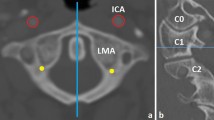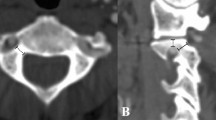Abstract
Purpose
To describe the effect of the C1 bursting fracture on the location of the internal carotid artery (ICA) around the atlas.
Methods
The authors analyzed the morphology of the atlas and the ICA in 15 patients with C1 bursting fracture and compared with control group (77 patients) without any pathology. All patients were evaluated with CT angiography for the anatomical assessment. The laterality of the ICA, the distances of the ICA from the midline, anterior tubercle, and ventral surface of the C1 lateral mass were compared between two groups. The distance between the lateral margin of the longus capitis muscle and the inner edge of the transverse foramen was also measured.
Results
Medially located ICA was more common in the C1 bursting fracture group than control group (76.7 vs 42.8 %). There were no significant differences between 2 groups for the distance from the midline, anterior tubercle, and ventral surface of the C1 lateral mass, respectively. The distance of the longus capitis muscle to transverse foramen was 2.52 ± 2.09 and 4.15 ± 3.09 mm in each group, and there was statistically significant difference (p < 0.01).
Conclusions
Lateral displacement of the bony structure of C1 bursting fracture changes the relative location of the ICA medially, which increase the injury risk during the bicortical C1 screw insertion. These data suggest that CT angiography or enhanced CT scans can give critical information to choose the ideal fixation technique and the proper trajectory of the screws for C1 bursting fracture.




Similar content being viewed by others
References
Abeloos L, De Witte O, Walsdorff M, Delpierre I, Bruneau M (2011) Posterior osteosynthesis of the atlas for nonconsolidated Jefferson fractures: a new surgical technique. Spine 36:E1360–E1363. doi:10.1097/BRS.0b013e318206cf63
Chung SK, Park JT, Lim J, Park J (2011) Open posterior reduction and stabilization of a C1 burst fracture using mono-axial screws. Spine 36:E301–E306. doi:10.1097/BRS.0b013e31820644cd
Troyanovich S (1994) C1 burst fracture. J Manipul Physiol Therapeutics 17:558–561
Zimmerman E, Grant J, Vise WM, Yashon D, Hunt WE (1976) Treatment of Jefferson fracture with a halo apparatus. Report of two cases. J Neurosurgery 44:372–375. doi:10.3171/jns.1976.44.3.0372
Tan J, Li L, Sun G, Qian L, Yang M, Zeng C, Teng H, Jia L (2009) C1 lateral mass-C2 pedicle screws and crosslink compression fixation for unstable atlas fracture. Spine 34:2505–2509. doi:10.1097/BRS.0b013e3181b4009a
McGuire RA Jr, Harkey HL (1995) Primary treatment of unstable Jefferson’s fractures. J Spinal Disorder 8:233–236
Koller H, Resch H, Tauber M, Zenner J, Augat P, Penzkofer R, Acosta F, Kolb K, Kathrein A, Hitzl W (2010) A biomechanical rationale for C1-ring osteosynthesis as treatment for displaced Jefferson burst fractures with incompetency of the transverse atlantal ligament. Eur Spine J 19:1288–1298. doi:10.1007/s00586-010-1380-3
Jo KW, Park IS, Hong JT (2011) Motion-preserving reduction and fixation of C1 Jefferson fracture using a C1 lateral mass screw construct. J Clin Neurosci 18:695–698. doi:10.1016/j.jocn.2010.08.033
Eck JC, Walker MP, Currier BL, Chen Q, Yaszemski MJ, An KN (2007) Biomechanical comparison of unicortical versus bicortical C1 lateral mass screw fixation. J Spinal Disord Tech 20:505–508. doi:10.1097/BSD.0b013e318031af8b
Hong JT, Lee SW, Son BC, Sung JH, Yang SH, Kim IS, Park CK (2008) Analysis of anatomical variations of bone and vascular structures around the posterior atlantal arch using three-dimensional computed tomography angiography. J Neurosurg Spine 8:230–236. doi:10.3171/SPI/2008/8/3/230
Currier BL, Todd LT, Maus TP, Fisher DR, Yaszemski MJ (2003) Anatomic relationship of the internal carotid artery to the C1 vertebra: a case report of cervical reconstruction for chordoma and pilot study to assess the risk of screw fixation of the atlas. Spine 28:E461–E467. doi:10.1097/01.BRS.0000092385.19307.9E
Estillore RP, Buchowski JM, Minhdo V, Park KW, Chang BS, Lee CK, Riew KD, Yeom JS (2011) Risk of internal carotid artery injury during C1 screw placement: analysis of 160 computed tomography angiograms. Spine J 11:316–323. doi:10.1016/j.spinee.2011.03.009
Hong JT, Lee SW, Son BC, Sung JH, Kim IS, Park CK (2006) Hypoglossal nerve palsy after posterior screw placement on the C-1 lateral mass. Case report. J Neurosurg Spine 5:83–85. doi:10.3171/spi.2006.5.1.83
Bogaerde MV, Viaene P, Thijs V (2007) Iatrogenic perforation of the internal carotid artery by a transarticular screw: an unusual case of repetitive ischemic stroke. Clin Neurol Neurosurg 109:466–469. doi:10.1016/j.clineuro.2007.02.008
Hoh DJ, Maya M, Jung A, Ponrartana S, Lauryssen CL (2008) Anatomical relationship of the internal carotid artery to C-1: clinical implications for screw fixation of the atlas. J Neurosurg Spine 8:335–340. doi:10.3171/SPI/2008/8/4/335
Currier BL, Maus TP, Eck JC, Larson DR, Yaszemski MJ (2008) Relationship of the internal carotid artery to the anterior aspect of the C1 vertebra: implications for C1–C2 transarticular and C1 lateral mass fixation. Spine 33:635–639. doi:10.1097/BRS.0b013e318166e083
Murakami S, Mizutani J, Fukuoka M, Kato K, Sekiya I, Okamoto H, Abumi K, Otsuka T (2008) Relationship between screw trajectory of C1 lateral mass screw and internal carotid artery. Spine 33:2581–2585. doi:10.1097/BRS.0b013e318186b2fd
Hong JT, Kim TH, Kim IS, Yang SH, Sung JH, Son BC, Lee SW (2010) The effect of patient age on the internal carotid artery location around the atlas. J Neurosurg Spine 12:613–618. doi:10.3171/2010.1.SPINE09409
Spence KF Jr, Decker S, Sell KW (1970) Bursting atlantal fracture associated with rupture of the transverse ligament. J Bone Joint Surg Am 52:543–549
Guo X, Ni B, Wang M, Wang J, Li S, Zhou F (2009) Bilateral atlas laminar hook combined with transarticular screw fixation for an unstable bursting atlantal fracture. Arch Orthop Trauma Surg 129:1203–1209. doi:10.1007/s00402-008-0706-7
Hein C, Richter HP, Rath SA (2002) Atlantoaxial screw fixation for the treatment of isolated and combined unstable jefferson fractures: experiences with 8 patients. Acta Neurochir 144:1187–1192. doi:10.1007/s00701-002-0998-2
Ma XY, Yin QS, Wu ZH, Xia H, Liu JF, Xiang M, Zhao WD, Zhong SZ (2009) C1 pedicle screws versus C1 lateral mass screws: comparisons of pullout strengths and biomechanical stabilities. Spine 34:371–377. doi:10.1097/BRS.0b013e318193a21b
Cyr SJ, Currier BL, Eck JC, Foy A, Chen Q, Larson DR, Yaszemski MJ, An KN (2008) Fixation strength of unicortical versus bicortical C1–C2 transarticular screws. The spine J 8:661–665. doi:10.1016/j.spinee.2007.02.008
Simsek S, Yigitkanli K, Seckin H, Comert A, Acar HI, Belen D, Tekdemir I, Elhan A (2009) Ideal screw entry point and projection angles for posterior lateral mass fixation of the atlas: an anatomical study. Eur Spine J 18:1321–1325. doi:10.1007/s00586-009-1105-7
Wang MY, Samudrala S (2004) Cadaveric morphometric analysis for atlantal lateral mass screw placement. Neurosurgery 54:1436–1439 (discussion 1439–1440)
Acknowledgments
The authors would like to acknowledge that this study was funded by the St. Vincent’s Hospital Research Program in 2014.
Conflict of interest
None.
Author information
Authors and Affiliations
Corresponding author
Rights and permissions
About this article
Cite this article
Kim, M.S., Kim, J.Y., Kim, I.S. et al. The effect of C1 bursting fracture on comparative anatomical relationship between the internal carotid artery and the atlas. Eur Spine J 25, 103–109 (2016). https://doi.org/10.1007/s00586-015-3848-7
Received:
Revised:
Accepted:
Published:
Issue Date:
DOI: https://doi.org/10.1007/s00586-015-3848-7




